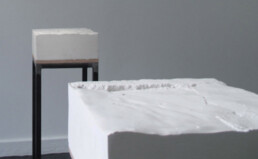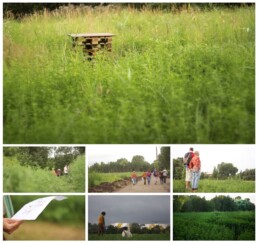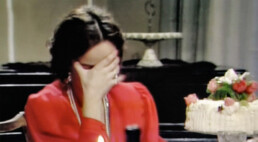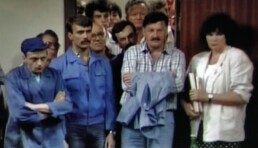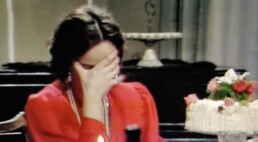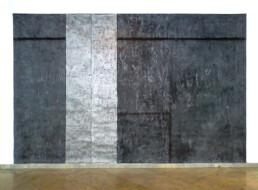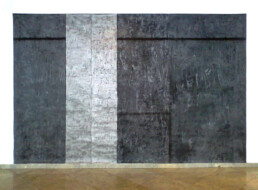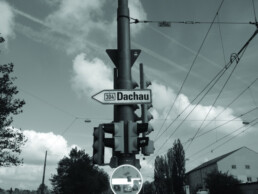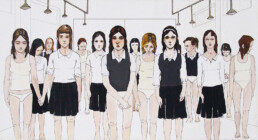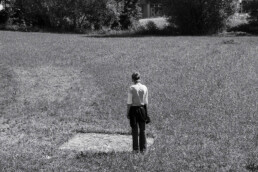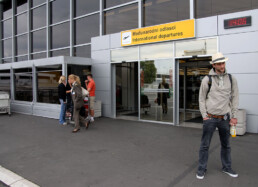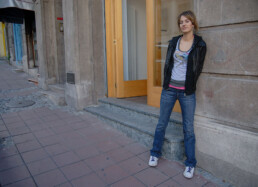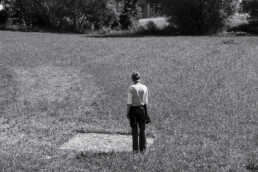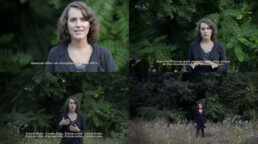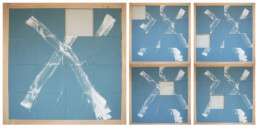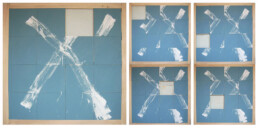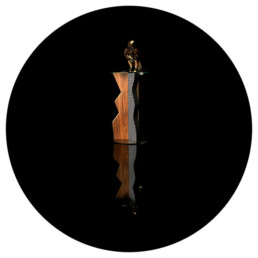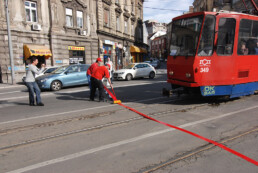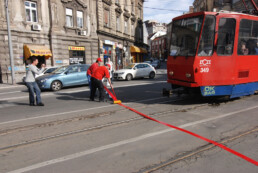Dušica Dražić
DUŠICA DRAŽIĆ (1979)
Industrial Arboretum
hand-made book, ink-jet printing; photograph, ink-jet printing
145 cm x 210 cm; 45 cm x 50 cm
edition: 14; edition 40
2012
Landscape
plaster
30 cm x 30 cm x 13 cm
2013
Industrial Arboretum
hand-made book, ink-jet printing; photograph, ink-jet printing
145 cm x 210 cm; 45 cm x 50 cm
edition: 14; edition 40
2012
During her residency within the MS Dockville Programme in Hamburg, Dušica Dražić explored the natural potentials of an abandoned industrial area in Wilhelmsburg. Originally, the work implied setting up of 11 observation platforms (like those used by ornithologists) and talks with locals, who contributed to the realization of a book containing almost all the plant species found in the mentioned area. Throgh her interest in transformations of different spaces, the artist also provides an insight into the changing of society.
Dušica Dražić participated in the 51st October Salon, The Night Pleases Us, with the work The Winter Garden, specifically made for that occasion, from plants found around and inside the building in which the exhibition was held. Her work was exhibited at the 55th October Salon, Disappearing Things, at the invitation of Curators Vanessa Muller and Nicolas Schaffhausen.
The work is produced by the Dokville Festival in Hamburg. It consists of two parts. Eleven platforms were set up in an abandoned industrial area, for which visitors were provided with a map with accurately marked positions, so that they could explore the mentioned place themselves and track daily changes in its urban landscape. The second part, which is in the Collection, is the book Industrial Arboretum, a collection of all the samples of vegetation found at the time when the work was created at that location. The work talks about the relationship among industry, nature and culture.
© Cultural Centre of Belgrade, October Salon Collection and the artist
Gift Contract: III-5-286/22.9.2014.
Inventory No. 1344
Photo: Milan Kralj
Landscape
plaster
30 cm x 30 cm x 13 cm
2013
The work belongs to the Landscapes Series, seven pieces in total, which were realized during her residency in Vienna and preceded the work Constructed Landscape, created shortly afterwards.
Looking at the landscape, observing its topography we stay in oblivion, not knowing how much time has past and how much force was needed to come to this moment we gaze into. By cutting into the landscape, we discover multiple layers. Although often invisible, a radical change of the surface we walk on is caused by deep, inner, continuous drifting of tectonic plates. Due to the slow, invisible migration of these plates and their interaction, this seemingly static landscape in front of us is constantly being recreated. Time is the crucial factor, but the most difficult to grasp.
If buildings are observed in the same way, we notice similar changes in their seemingly stable structures. “Landscapes” are precise plaster casts of cracks of architectural elements in the city. Placed horizontally, on plinths they start to resemble these slowly formed landscapes. (https://dusicadrazic.wordpress.com/portfolio/landscapes/)
In cooproduction with bm:uk (Bundesministerium fur Unterricht, Kunst und Kultur)
© Cultural Centre of Belgrade, October Salon Collection and the artist
Gift Contract: III-5-517/24.12.2014.
Inventary No. 1390
Photo: Milan Kralj
ABOUT THE AUTHOR:
The issues that Dušica Dražić (1979, Belgrade, Serbia) explores within her art practice deal with the ambivalent interrelationship of the citizen and the city, their mutual support and protectiveness, but also their isolation and destruction. Dražić searches for spaces of irregularity, difference, flexibility rethinking them at the level of cultural continuity, symbolic irregularities and individual actions. She looks for traces that show how culture is constantly being negotiated, redefined and transformed. Dražić exhibited works internationally in solo and group exhibitions and was a resident at Q21/MQ (Vienna), Iaspis (Stockholm), ISCP (NYC), KulturKontakt (Vienna), Tobačna 001 (Ljubljana). Dražić also initiated and curated collaborative projects and exhibitions. In 2018 she founded Out of Sight_ A venue for contemporary in Antwerp, together with Wim Janssen. More information at www.dusicadrazic.com and www.out-of-sight.be
DOPLGENGER
DOPLGENGER
Fragments Untitled #2
single-channel video projection
6’10”
edition: 1/5
2014
Fragments Untitled #2
single-channel video projection
6’10”
edition: 1/5
2014
Using the sequences of one of Yugoslavia’s most popular TV series, A Better Life, the work Fragments Untitled #2, reveals images that testify to the accelerated political and economic changes in Yugoslavia during the 1980s and in the early 1990s.
Fragments Untitled is a series of works dealing with the politics of media images that participated in creating the historical narratives of Yugoslavia in the period of 1980-2000.
At the 55th October Salon, Disappearing Things, two works from the series, Fragments Untitled #1 and Fragments Untitled #2, were exhibited.
A Better Life is a Yugoslav TV series, produced by Television Belgrade, which achieved tremendous ratings in the former Socialist Federal Republic of Yugoslavia. This 82-episode series with elements of soap opera, comedy and drama, premiered between 1987 and 1991, is considered the most popular series in the former Yugoslavia.
The character of Ema, one of the main protagonists, torn between petty bourgeois and socialist values, illustrates the problem of a value-system mismatch in a society sliding towards destruction. By summarizing the first forty episodes in six minutes, the effect of anticipation of something terrible and unknown that is inevitably coming is created.
The Fragments Untitled Project analyses, deconstructs and appropriates media images to indicate the operation of media machinery and manipulation it produces. The films are realized through the method of deconstruction of the existing archive material.
This series of works recreates the context of media content, highlighting what was previously invisible and suppressed, what remained marginalized or considered ephemeral in the media stream.
From the catalogue of the 55th October Salon
© Cultural Centre of Belgrade, the October Salon Collection and the artist
Purchase Contract: III-5-166/1.6.2016.
Inventory No. 1425
Photo: still from the video work
Selected Bibliography:
55th October Salon, Disappearing Things. Cultural Centre of Belgrade, 2014
The 6th Cairo Video Festival, Nov. 8 – 20, 2014, Catalogue, Medrar for Contemporary Art / Gezira Art Center / Zawya Cinema, Cairo, Egypt, 2014
Neimenovani fragmenti [Fragments Untitled], Dec. 23, 2014 – Jan. 12, 2015, texts by Aneta Stojnić, Nikola Dedić, Exhibition Catalogue, Youth Centre Gallery, Belgrade, 2015
ABOUT THE AUTHOR:
Doplgenger is an artist duo – Isidora Ilić (1978, Belgrade, Serbia) and Boško Prostran (1979, Belgrade, Serbia). Doplgenger’s work deals with the relation between art and politics through exploring the regimes of moving images and modes of its reception. They deconstruct the film medium, language, structure, and text in order to discover the ways in which art/moving images participate in creating political reality. They rely on the traditions of experimental film and video and, with some of the procedures in those traditions, intervene on the existing media products. Doplgenger’s work has been presented in Serbia and abroad, at solo and group exhibitions and at film and video festivals around the world. More information at http://www.doplgenger.org
Perica Donkov
PERICA DONKOV (1956)
Points of support
acrylic, graphite and silver pigment on natron paper 350gr
480 cm x 300 cm
2013
Points of support
acrylic, graphite and silver pigment on natron paper 350gr
480 cm x 300 cm
2013
Perica Donkov’s work is defined as new art informel, explained as “sign, gestural and matter painting, for the second time” – a movement that emerged on the Yugoslav art scene during the 1980s, characterized by a pronounced non-figurativeness and predilection for painting matter. His work is based on the idea that art is an articulation of existential hardships and that it can provide a spiritual shelter from the downfall of civilization. With the necessary but not drastic changes in visual expression, with a constant preference for monumental formats, at the beginning of the 21st century, Donkov reduced the use of colour to black, white and lead grey, always remaining in the sphere of visuality, without narration, motif or objectness.
The work in the October Salon Collection is an attempt to establish the image space determined by the points of support. The space is formed by horizontals and verticals without a specific pattern, which give orientation to chaotic homogeneity and a certain kind of sacrality. This sacrality is achieved by the monumental dimensions, but also by emphasizing the wide vertical silver field that stands out in relation to the dark font of the painting. The vertical, with its symbolic values, is the main constructive principle in the process of sacralization of a space, in this case, the space of the painting. It symbolizes the evolution of the spirit, becoming a pillar, i.e., a point of support for a person’s spiritual change. This sacrality is not necessarily perceived in the Christian key, but it opens the door to contemplativeness at the general civilization level. “I create a shelter, a personal space for the prayers of a vulnerable individual who recognizes and confronts nonsense. My works are icons of a believer in the existence, persistence and supremacy of the spiritual over the material.” (Perica Donkov)
If we start from the presumption that non-referential painting stems from contemplation, then Perica Donkov’s painting is a direct reaction, his memory and understanding of the world around him. The work has a communicative potential, because with its visuality that starts from the material, it abstracts emotions and intellect into the field of contemplation and calls for the displacement of the viewer into segments of the spiritual and the non-material. Although dark in colour, the painting does not represent the artist’s pessimistic view of the world, but rather, in his own words, opens up the fields of a new humanism.
© Cultural Centre of Belgrade, the October Salon Collection and the artist
Purchase Contract: III-5-379/16.11.2016.
Inventory No. 1454
Photo: Courtesy of the artist
Selected Bibliography:
Perica Donkov, Exhibition Catalogue No.52 (KG), Apr. 11 – May 6, 2019, author of the text Milica Todorović, RIMA Gallery, Kragujevac
Mileta Prodanović, Perica Donkov: A Picture as a Shelter. Texts: Ješa Denegri and Danijela Purešević. Translated by Novica Petrović Belgrade: Vujičić Collection Foundation, 2015
Milica Todorović, Perica Donkov: Works 2016–2019 (monograph to be published soon), Stevan Sremac Public Library, Niš, 2020
http://www.politika.rs/scc/clanak/16318/ and http://www.politika.rs/sr/clanak/445563/Politikina-nagrada-za-najbolju-izlozbu-Perici-Donkov (accessed April 2, 2020)
ABOUT THE AUTHOR:
Perica Donkov (1956, Mazgoš, Serbia). He graduated (in 1981) and received his master’s degree (in 1984) from the Painting Department of the Faculty of Fine Arts in Belgrade, under Professor Radenko Mišević. Since 1983 he has been a member of ULUS (Association of Fine Artists of Serbia), first in the status of a freelance artist, and later of a distinguished artist, and in 2018 became a member of the Council of the Serbian Academy of Sciences and Arts – Branch in Niš. He has received 15 national awards for painting, from the FLU Student Award in 1980 and the University of Arts Award in 1981, to the Nadežda Petrović Gallery Award in 1984, Đorđe Krstić in 2001, ULUS Golden Palette in 2007, Beli anđeo [White Angel] in 2007, Milan Konjović in 2010, Politika Award from the Vladislav Ribnikar Fund in 2020, the 11th of January – the highest award of the City of Niš in 2010. He has had 35 solo exhibitions in the country and abroad, participated in more than 200 group exhibitions and in all major art events in Yugoslavia and Serbia (Controlled Gesture, Yugoslav Documents 89, Thirty Most Important Artists of the 1980s and 1990s in Yugoslavia, Biennial of Young Artists, October Salon, etc.). His works are part of major public museum and gallery collections in the country and some private collections (Vujičić, Popović, Trajković, Erić, RIMA, Marjanović, Wiener Städtische, Telenor, Philip Morris). Since 2008 he has been a full professor at the Faculty of Arts in Niš.
Uroš Đurić
UROŠ ĐURIĆ (1964)
Life as Such
video
twelve clips of varying duration
2012–2015
Life as Such
video
twelve clips of varying duration
2012–2015
The series of video recordings is about the absence of a coherent narrative, pointing to the scenes of the world filmed at different locations and in diverse situations over a period of three years (2012-2015), in Belgrade, Prague, Maribor, Munich, Paris, Ohrid, Berlin, Raška, Rennes, Trieste and other places. They all testify about general state of limbo, about the kind of life that an individual perceives between turning points in history, a life devoid of big decisions, ambiguities or mystifications, devoid of the need to say something truly radical or new until the first sprouts of growing resistance against the exploitatively tailored reality articulate.
Unlike Đurić’s dominant practice of presenting himself as a “theoretical character” in most of his works, this time we see the author and his social framework, the social scene through which he moves. The video works or film recordings, as the artist points out, are edited in units, but individually, they have the flexibility to be shown in different ways. By their structure, some recordings appear to be performative, while others are characterized by documentary-situationist potential. Situations are different, from those intimate, with moguls of gallery and art life at fairs, to proletarian situations, with marginalized artists in Munich, etc. The recordings show the layeredness and the abundance of hidden social comments, which the artist provokes to reveal themselves, provided that the viewer is sufficiently socially, visually and semantically literate.
© Cultural Centre of Belgrade, the October Salon Collection and the artist
Purchase Contract: III-5-380/16.11.2016.
Inventory No. 1449
Photo: stills from the video works
Selected Bibliography:
Uroš Đurić: Život kao takav, Nov. 19 – Dec. 12, 2015, Podroom Gallery, Cultural Centre of Belgrade, text for the solo exhibition, 2015
Uroš Đurić / Život kao takav, Feb. 9, 2016, Supervizuelna – online magazine for contemporary art https://www.supervizuelna.com/uros-duric-zivot-kao-takav-1-deo/
https://www.supervizuelna.com/uros-duric-zivot-kao-takav-2-deo/ (accessed on May. 9, 2020)
ABOUT THE AUTHOR:
Uroš Đurić (1964, Belgrade, Serbia) studied art history at the Faculty of Philosophy (1984–87) and painting at the Faculty of Fine Arts in Belgrade, from which he graduated (1992) and received a master’s degree (1998). He has actively exhibited since1989 and presented his work at Jeu de Paume in Paris, Kunsthalle Fridericianum in Kassel, Austrian Cultural Forum in New York, Kunsthalle in Vienna, Zaheta Gallery in Warsaw, Frankfurter Kunstverein, Museum of Modern Art in St. Etienne, Secession in Vienna, Katzen Arts Center in Washington, Tecla Sala Cultural Centre in Barcelona, Museum Moderner Kunst Sammlung Ludwig Wien in Vienna… He has collaborated with Harald Szeemann, René Block, Marina Gržinić, Gerald Matt, Lorand Hegyi, Lenka Klodová, Thomas Trummer, Gabi Mackert, Toby Mayer, Yara Bubnova, Thomas Miessgang, Victoria Combalia, Jiři Ševčik, Mika Georgescu, Goranča Đorđijevski, Ivan Mečl… His works are part of the collections of Ludwig Museum in Vienna, Essl in Klosterneuburg, EVN in Maria-Enzersdorf, Antoine de Galbert in Paris, Museum of Contemporary Art, Telenor, Zepter Museum and City Museum in Belgrade, Museum of Contemporary Art of Vojvodina in Novi Sad, as well as of numerous private collections throughout Europe. Lives and works in Belgrade.
Biljana Đurđević
BILjANA ĐURĐEVIĆ (1973)
The Future Brings Us Nothing!
indian ink, pen, acrylic on canvas
38 cm x 71 cm
2010
The Future Brings Us Nothing!
indian ink, pen, acrylic on canvas
38 cm x 71 cm
2010
The drawing/painting The Future Brings Us Nothing! deals with the problem of Memento Vivere, as a counterpoint to the often used theological phrase Memento Mori. It belongs to the group of works related to the series Systematic Examination and Synchronised Swimming. Her works were exhibited at the 50th October Salon in 2009 and the 56th October Salon in 2016.
In the drawing The Future Brings Us Nothing! the space where the young girls are is part of the school bathrooms. A sort of allusion to a more sinister environment is deliberately left. The frozenness of the scene creates a sense of “before” and “after”, thus increasing the tension and bringing dramatic charge into the work. Violence is not explicit but occurs in the viewer’s imagination. The focus is on the condition of young people in development, who do not sublimate their fear but suppress it, creating frustrations that often mark their lives.
With a realistic approach and an abundance of symbols, the artist examines the phenomena of alienation, social anxiety, aggression, and criticizes contemporary society and its ideals with her specific poetics. Her paintings are full of emotional tension; the portrayed people often gaze hypnotically at the viewer, thus “drawing” them into the painting, while the bodies of the figures are most often in a dramatic relationship with other bodies or the space that surrounds them. This space is often embellished with decorative elements, which only at first glance mitigate the associative elements of brutality.
© Cultural Centre of Belgrade, October Salon Collection and the artist
Purchase Contract: III-5-157/25.5.2016.
Inventory No. 1478
Photo: Courtesy of the artist, Milan Kralj
Selected Bibliography:
Aesthetics of Violence – Three Solo Exhibitions: AES+F Group – Norbert Bisky – Biljana Đurđević. January 24 – June 6, 2009. Curator Tami Katz-Freiman, Catalogue of the Exhibition Haifa Museum of Art, Haifa, 2009. Available at: http://www.katzfreiman.com/wp-content/uploads/2015/03/VIOLENCE.pdf (accessed on Mar. 18, 2020.)
50th October Salon, Circumstance. Cultural Centre of Belgrade, 2009
Biljana Đurđević, text Miroslav Karić, Catalogue of the Solo Exhibition, Oct. 6 – 19, 2015, Rima Gallery, Kragujevac, 2015
ABOUT THE AUTHOR:
Biljana Đurđević (1973, Belgrade, Serbia) graduated and received her PhD degree from the Faculty of Fine Arts (Painting Department) in Belgrade. Since 2009 she has been working at the Painting Department of that faculty, and in 2012 was elected Assistant Professor. In 2010 and 2011, she was a guest lecturer at the Parsons New School for Design in New York. She is a recipient of the Politika Award (Vladislav Ribnikar Fund) for the best exhibition in 2012. Her works are part of public and private collections in the country and abroad such as: Moderna Museet, Sweden; Podesta Collection, USA; C-Collection, Switzerland; Museum of Contemporary Art Belgrade; Frissiras Museum, Greece; Essl Collection, Austria; Askona Museum of Modern Art, Switzerland, etc. More information at http://biljanadjurdjevic.com/
diSTRUKTURA
diSTRUKTURA
We Are Living in a Beautiful wOURld (Nemanja)
print on alucobond
80 cm x 110 cm
2007
We Are Living in a Beautiful wOURld (Smiljana)
print on alucobond
80 cm x 110 cm
2007
HomeLand (Pöllauer Tal 1)
digital print, lined
40 cm x 84 cm
2010
HomeLand (Pöllauer Tal 2)
digitaln print, lined
40 cm x 60 cm
2010
Locus Suspectus
video
2’51”
2014
We Are Living in a Beautiful wOURld (Nemanja)
print on alucobond
80 cm x 110 cm
2007
We Are Living in a Beautiful wOURld (Smiljana)
print on alucobond
80 cm x 110 cm
2007
The work thematizes individual experiences of artists – emigrants from the countries of the former Yugoslavia, who search for their identity and position in Graz in a new, sometimes hostile environment, where they are recognized as “others”, despite all attempts at adaptation.
It is part of the photographic installation exhibited at the 48th October Salon.
We Are Living in a Beautiful wOURld is a work in progress, initiated by deeply personal understanding of social and political conditions in our country. In search of a better life, people are leaving Serbia and we’ve become aware that we are losing more and more friends. We’ve decided to make photographs of these young people as part of a collection of memories of their uncertain destinations. Every time someone decides to go to a foreign country to look for a better life we are called to witness the moment of their final choice. They all have the same reasons and they are all related to the state, political and social situation.
The work was started in 2007 with a series of photographs (digital print on alucobond, 80 cm x 110 cm), and later developed and included other works such as: Oblivion Statistic (installation, 400 x 400 x 250 cm, 48th October Salon), Simple Statements (4 lightboxes, 40 cm x 50 cm each, 2008, Belef), Homeland (intervention in public space, Pöllauer Tal Nature Park, Austria 2010 , Gleisdorf 2013), On Certainty (video, 5’22 ”, 2010), and the site-specific work We Are Living in a Beautiful wOURld – Graz, within the Generation Lost Project.
diSTRUKTURA
© Cultural Centre of Belgrade, the October Salon Collection and the artist
Gift Contract: III-5-538/30.12.2014.
Inventory No. 069, 070
Photo: Courtesy the artist
Selected Bibliography:
diSTRUKTURA: their very landscape is alive, Oct. 22 – Nov. 14, 2015, Cultural Centre of Belgrade, 2015
diSTRUKTURA / Joint Venture, 2005–2015, ProArtOrg, Belgrade, 2016
We Are Living in a Beautiful wOURld – Austria, ProArtOrg, Belgrade, 2016
HomeLand (Pöllauer Tal 1)
digital print, lined
40 cm x 84 cm
2010
HomeLand (Pöllauer Tal 2)
digitaln print, lined
40 cm x 60 cm
2010
The work was realized in the Pöllauer Tal National Park near Graz. It was an intervention in nature during which the artists dug a hole measuring 2 x 2 m and filled it with the soil they brought from Serbia. The character of the work was to point to the processes of assimilation and acceptance during emigration.
With the work HomeLand, diSTRUKTURA formulate the questions about how a landscape circulates as a means of exchange, a place of visual appropriation and a focus in forming identities. According to the artists, in addition to being a geographical concept, Central Europe is primarily a historical, cultural, political and ethnographic concept that refers to countries between Eastern and Western Europe. Particularly the term Mitteleuropa refers to the territory where Austrian culture was highly dominant before the First World War, and which mostly coincides with the contemporary definition of Central Europe.
© Cultural Centre of Belgrade, the October Salon Collection and the artists
Gift Contract: III-5-538/30.12.2014.
Inventory No. 071, 072
Photo: Courtesy the artist
Selected Bibliography:
diSTRUKTURA / Joint Venture, 2005–2015, ProArtOrg, Belgrade, 2016
We Are Living in a Beautiful wOURld – Austria, ProArtOrg, Belgrade, 2016
Locus Suspectus
video
2’51”
2014
Locus Suspectus, a joint video work by diSTRUKTURA and conceptual writer Barbi Marković, shows the landscape of the city of Sarajevo, precisely, the place of the assassination of Archduke Franz Ferdinand, in the space in front of the Latin Bridge, at the crossroads of the streets Obala Kulina Bana and Zelenih beretki.
In the video work, the narrator/writer reads records from the city streets using the cut-up technique. Merging the unrelated sentences, concepts and observations collected randomly at the place where the assassination took place, the author of the text aims to show the aura of the city, people and time, which enabled a comparison between the present and the past – emphasizing the differences and common characteristics imprinted in the mentality of the nation. Jelena Pavićević, Likovni život, 2018
The video was filmed in Košutnjak in Belgrade, where, in a perfectly natural environment, Barbi narrates the city autobiography and constructs a story about its values, codes and problems. Throughout this 25-minute-long narration, in which the frame slowly widens revealing the forest environment, we become aware of how history, through signs and codes, is transmitted through time and space, and how space remembers events.
© Cultural Centre of Belgrade, the October Salon Collection and the artist
Purchase Contract: III-5-159/25.5.2016.
Inventory No. 1477
Photo: still from the video work
Selected Bibliography:
diSTRUKTURA Story Lines, Mar.12 – Apr. 20, 2020, catalogue of the solo exhibition, Museum of Contemporary Art of Republika Srpska, Banja Luka, 2020
diSTRUKTURA: their very landscape is alive, Oct. 22 – Nov. 14, 2015, Cultural Centre of Belgrade, 2015
diSTRUKTURA / Joint Venture, 2005–2015, ProArtOrg, Belgrade, 2016
ABOUT THE AUTHORS:
Milica Milićević (1979, Belgrade, Serbia) and Milan Bosnić (1969, Belgrade, Serbia) graduated and obtained their master’s degrees from the Faculty of Fine Arts in Belgrade, Painting Department. Since 2005, they have been working on joint projects as the artist duo – diSTRUKTURA. The media in which they work are primarily photography, painting, drawing and video. Their works have been presented in the country and abroad at solo and group exhibitions and are part of private, public and corporate collections in the country and abroad. They have participated in various residency programmes, symposia and workshops in Spain, Germany, France, Switzerland, the Netherlands, Austria, Italy, Slovenia, Egypt, Serbia and Finland. More information at: www.distruktura.com
Aleksandar Dimitrijević
ALEKSANDAR DIMITRIJEVIĆ (1977)
Big X
acrylic on hardboard
220 cm x 220 cm
2007
Big X
acrylic on hardboard
220 cm x 220 cm
2007
At the heart of this great interactive image – jigsaw puzzle, as the artist calls it, are sixteen space segments, one of which is an empty space. The term puzzle itself refers to a multitude of segments that need to be fitted into a whole with the help of one empty space, which allows for movement, moving of all segments as well as the empty space.
He participated in the 47th October Salon in 2006, at the invitation of Art Director René Block.
The Big X belongs to a series of works made in the period 2005-2007. Dimitrijević presents them as part of a project related to social games, a result of his deliberation on the relationship between the viewers and the work of art. In this particular case, this process is a game that consists of constructing and deconstructing – assembling and not assembling, through which the viewer is involved in the creative process.
The game offers enjoyment and the possibility of countless repeats of lost values, but also of discovering new ones. By playing with the pieces of the puzzle (image), we create a new image.
© Cultural Centre of Belgrade, October Salon Collection and the artist
Gift Contract: III-5-291/25.9.2014.
Inventory No. 1352
Photo: Courtesy of the author
Selected Bibliography:
47th October Salon, Art, Life and Confusion. Cultural Centre of Belgrade, 2006
Collection of Serbian Contemporary Art, Telenor Foundation, 2007, p. 70–71.
http://contemporarybalkanart.com/portfolio/aleksandar-dimitrijevic/
http://www.serbiancontemporaryart.info/index.php/en/homepage/item/39-aleksandar-dimitrijevic?texts=1
http://www.telenorkolekcija.rs/media.php
ABOUT THE AUTHOR:
Aleksandar Dimitrijević (1977, Užice, Serbia) graduated in painting (2004) and received his master’s degree in drawing (2010) from the Academy of Arts in Novi Sad. He has presented his works at numerous solo and group exhibitions in the country and abroad and won a number of awards. His works are part of many private and public collections. In 2016, he founded the Centre for Visual Artists and in 2017, the Reflektor Gallery in the old barracks in Užice. He has won the Jelena Šantić Award for outstanding results in new cultural practices for the Reflektor Gallery Project. More information at www.dimitrijevica.com
Marko Crnobrnja
MARKO CRNOBRNjA (1978)
Accreditation
wood, terracotta
120 cm x 25 cm x 20 cm
2015
Accreditation
wood, terracotta
120 cm x 25 cm x 20 cm
2015
It is an educational sculpture, patented as a solution to all the verbal shortcomings of an optimistic parent, who believes that art cannot change the world, but can help raise playful sons.
Since 2003, Marko Crnobrnja has made educational sculptures intended primarily for his own children and, initially, for him himself, so that he – with the (in)experience of a young parent and also a young sculptor – could master and, at the same time, reconcile the two serious roles in which he found himself. Over the years, his work has taken a specific authentic form – his sculptures have become educational tools, but also an autonomous artistic expression, a meeting place of two practices / two strategies (artistic and parental), but also a methodologically developed system of meaning and marking. With the work Accreditation, Crnobrnja draws attention to the relationship between parent and child; the allegorical composition with several figures of father and son represents the relationship between two generations, two methods of learning – indicating that the role of the parent in raising a child is a Sisyphean task.
© Cultural Centre of Belgrade, the October Salon Collection and the artist
Purchase Contract: III-5-384/16.11.2016.
Inventory No. 1448
Photo: Milan Kralj
Selected Bibliography:
Gordana Stanišić, O velikim malim ljudima i malim velikim brigama skulptura Marka Crnobrnje, Vujičić Collection, Belgrade, 2019
ABOUT THE AUTHOR:
Marko Crnobrnja (1978, Obrenovac, Serbia) graduated and obtained a master’s degree from the Faculty of Fine Arts in Belgrade, Sculpture Department, in 2005. Since 2017 he has worked at the Faculty of Applied Arts in Belgrade. He presents his works at solo and group exhibitions, and they are part of private and museum collections in the country and abroad. He has won various awards in the field of art, including the annual award of the City of Šabac, Ključ grada [Key of the City], for artistic solution in 2015; Third Prize for Design from the Chamber of Commerce of the City of Belgrade in 2014; Award at the Contest for the Official Souvenir of the Republic of Serbia at the SHANGHAI EXPO 2010; Second Prize at the Festival of Light in Ljubljana LAMPATUSH in 2009, etc. A co-founder of the Štap&Kanap Redesign Studio.
Jasmina Cibic
JASMINA CIBIC (1979)
Perch for parabuteo unicinctus (E. Sottsass)
lambda print
100 cm x 100 cm
edition: 1/5
2010
Perch for parabuteo unicinctus (E. Sottsass)
lambda print
100 cm x 100 cm
edition: 1/5
2010
The print is part of the work entitled 20th Century that represents a photographic series with sculptures, which the artist created specifically for the 6th Triennial of Contemporary Art in Ljubljana. Cibic has worked with a trainer of birds of prey to produce this study of the birds’ movements and their interaction with sculptures which she intentionally made as replicas of some of the most iconic design objects of the 20th century.
The co-habitation of the two elements seeks to promote the analysis of two examples of commodification – architecture of display and the work of art as such. The artist uses the image of birds of prey as a strong leitmotif throughout her practice, as a symbol of shifting degrees of souvenir production: hunting birds were initially used by man to satisfy the basic needs for food, only later did the humankind begin to substitute their value for a cultivated experience of nature, as a trophy and an ornament. People who possessed sufficient power were placing stuffed birds and other animals next to precious and famous art and design objects. Stemming from this fact Cibic questions the status of the work of art, its significance, its policies of representation and its relationship to the spectator.
Miha Colner
The work was exhibited also within the 54th October salon exhibition in Belgrade.
The new series of work from Jasmina Cibic takes as its theme an investigation into the level of meanings of those objects to which the West has ascribed the ability to trigger experience. Souvenirs from other lands, fictional icons, photographs, design objects and obviously – on top of the social ladder of values – works of art, are all instruments that allow the viewer to experience that which is for various reasons unattainable directly, and it is for this reason that a surplus value (mythical, subjective, market driven, aesthetic, political, cultural and ideal) is inscribed within these objects in the first place. Cibic explores the reasons for these shifts in values and the processes and conditions of experience itself under which these are made possible.
The series 20th Century consists of a series of photographs which depict birds of prey resting on what seem to be at a first glance perches. These hunting birds, initially used by man to satisfy basic requirements, only later become bearers of status and a symbol of luxurious pursuit. At this point their owners substitute their use value with that of a cultivated experience of nature. Within this process of shift from utility object to trophy object we recognize a release of sentimental, cultural, social and market value towards the viewer. Perhaps it is for this reason that genuine trophies, gathered on the voyages of the bourgeoisie in faraway lands, are substituted by fake replicas, consumer goods and souvenirs which have none of the real essence itself of the thing which is supposed to be remembered in the first place…
Petja Grafenauer
© Cultural Centre of Belgrade, October Salon Collection and the artist
Gift Contract: III-5-288/1/23.9.2014.
Inventory No. 1349
Photo: Courtesy of the artist
ABOUT THE AUTHOR:
Jasmina Cibic (1979, Ljubljana, Slovenia) is a London based artist who works in performance, installation and film, employing a range of activity, media and theatrical tactics to redefine or reconsider a specific ideological formation and its framing devices such as art and architecture. Her work draws a parallel between the construction of national culture and its use value for political aims, addressing the timelessness of psychological and soft power mechanisms that authoritarian structures utilise in their own reinsertion and reinvention.
Jasmina Cibic represented Slovenia at the 55th Venice Biennial with her project “For Our Economy and Culture”. Cibic’s recent monograph Spielraum is published by BALTIC and Distanz and NADA by Kerber Verlag and Kunstmuseen Krefeld. More inforamtion at http://jasminacibic.org/
Vlаdаn Cаričić
VLADAN CARIČIĆ (1960)
Across the Red Thread
video
17’17”
1987–2012
The End of Red Thread
video
15’
2012–2014
Red Thread Crossing
video
6’36”
2012–2014
Across the Red Thread
video
17’17”
1987–2012
© Cultural Centre of Belgrade, the October Salon Collection and the artist
Gift Contract: III-5-293/1/29.9.2014.
Inventory No. 041
Photo: still from the video work
The End of Red Thread
video
15’
2012–2014
© Cultural Centre of Belgrade, the October Salon Collection and the artist
Gift Contract: III-5-293/1/29.9.2014.
Inventory No. 064
Photo: still from the video work
Red Thread Crossing
video
6’36”
2012–2014
© Cultural Centre of Belgrade, the October Salon Collection and the artist
Purchase Contract: III-5-520/24.12.2014.
Inventory No. 1392
Photo: still from the video work
The Ted Thread Trilogy consists of three video works made for the 53rd October Salon in 2012. The immediate inspiration were the spaces of Savamala and the Belgrade Cooperative Building, where the Salon was held, and the Salon’s slogan “Good Life”, which was so drastically in contrast with the reality of once the capital’s most beautiful area, then suffocated with traffic and bizarre contents. That is how the red thread was formed, a thin line stretched in space, which warns of invisible contents with the exciting forgotten history behind. Red Thread represents a thin, warning line between antipodes, the good and bad, the beautiful and ugly, the forgotten and marked without good reason.
With the work Across the Red Thread, Caričić returns to the Belgrade Cooperative Building, to the space where he made the film The Harms Case with some friends. Besides reconstructing of Harms’ film room, he felt a need to say something about the collapse of this significant Savamala space. So the red thread drew a line between the found run-down spaces and a possible “good life” if only as a set for the longest frame in Yugoslav cinematography, shot there a long time ago. Originally, Red Thread Crossing was created as a performance that Caričić, with his associates, carried out at the 53rd October Salon. A cross symbolically placed over the junction of five streets in front of the Belgrade Cooperative was a desire to finally break with ephemeral contents that suppressed once distinctive life of Savamala. Finally, The End of Red Thread, the last part of the Red Thread Trilogy, created at the moment of closing of the 53rd October Salon, represents a symbolic cutting of the “fateful” old beam, which poses a challenge to return the spirit of good events to the space of Savamala.
Selected Bibliography:
53rd October Salon, Good Life: Physical Narratives and Spatial Imaginations. Cultural Centre of Belgrade, 2012
ABOUT THE AUTHOR:
Vladan Caričić (1960, Belgrade, Serbia) is a film and TV scenographer and producer.
He has dedicated different periods in his personal and professional life to exploring the possibilities of transmitting visual information and illusion to viewers, as a TV reporter and Balkans correspondent for the Finnish Broadcasting Company in the late 1980s, as a production designer and as an author who reconstructs and evokes different periods in history. In his rich scenographic opus, he has realized some of the most-viewed shows ever broadcast in the region, such as the puppet TV series Never Sorry. He tried his hand in various genres – from the children’s series Tricks and Gimmicks to the first feature film produced by the Serbian Orthodox Church – Christmas Song and the historical comedy Black Gruja and the Stone of Wisdom. In the film The Harms Case, he sought to make the rundown and grey city of Belgrade into a fantasy of a post-revolutionary red Leningrad in the time of the avant-garde, that appeared and disappeared in an eye blink. He participated in the 53rd October Salon in Belgrade. Since 2012, he has been developing the Traveling Museum of New Primitivism Project with Sejo Sexon. At eight exhibitions of this museum, a number of art installations inspired by the New Primitive Movement have been realized (Zagreb, Ljubljana, Sarajevo, Tuzla, Banja Luka, Novi Sad, Belgrade). A co-author (with Siniša Žarin) of the exhibition Living in Danube Banovina, held at the RTS Gallery during the winter of 2014, which presented the concept of the Forgotten Arts Museum from Novi Sad.
